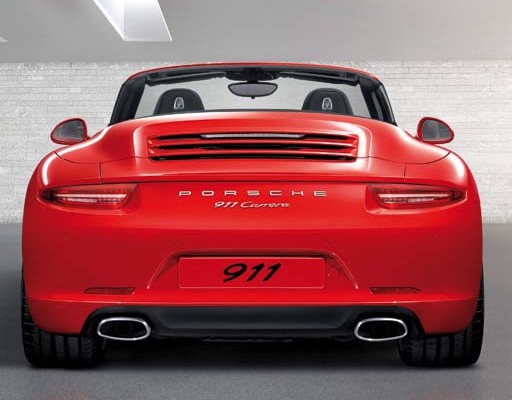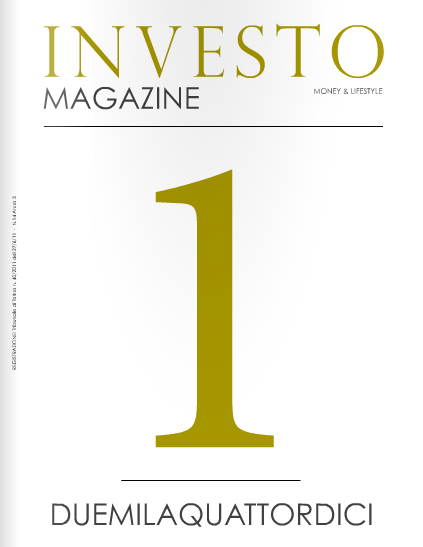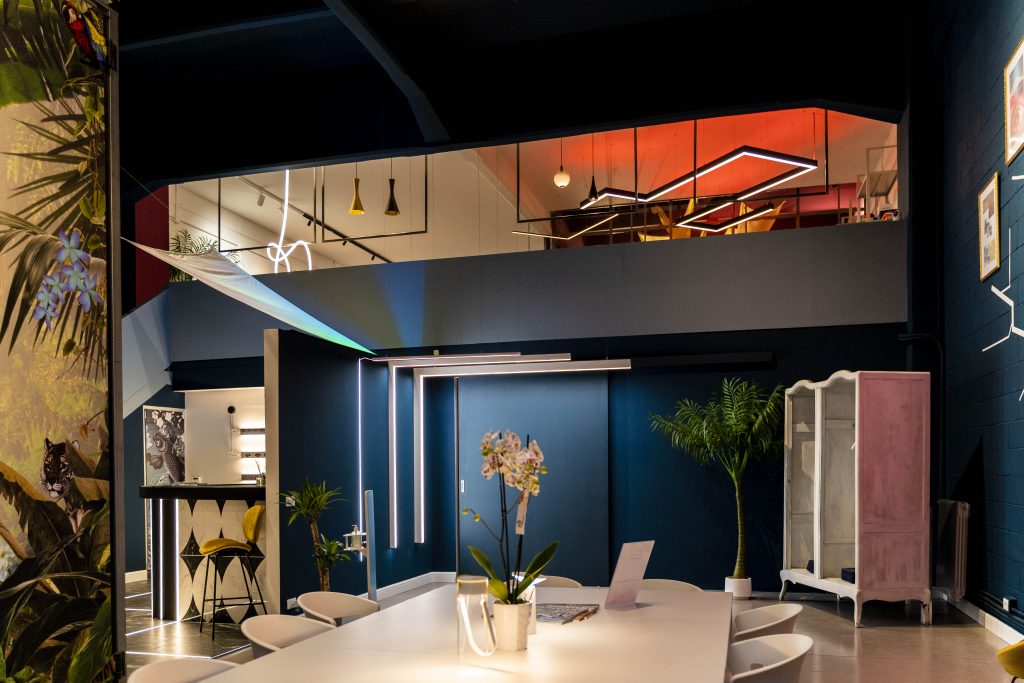Porsche 911 Carrera S Cabriolet (991)
POWER: 400 hp PRICE: 142.000,00 € DRIVER: Marco Longhini
It is a quite interesting moment for the Porsche 911 as we are celebrating its first 50th anniversary and there are still two generations overlapping: the most performing models, the 997 series, and the new ones who are gradually upgrading into specific versions based on the 991; among them, the Carrera S Cabriolet.
This is the sixth embodiment of the 911 but, as usually when dealing with the Zuffenhausen sport car, there are differences, and many, but they are not necessarily to be seen. It appears to have only minor exterior updates as per dimension (52mm larger inside, 56 mm longer, 3 mm reduced height from the ground; a loss in weight of 60 kg despite a 100 mm longer pitch that gives a 2,5 cm plus to passenger sitting in the front) that, together with more generous air intakes, the standard 20” wheel tire, new rear headlights and cutting edge technology is used for the front light units (without exploring new and dangerous roads, as was the case with the 996) give the car a strong visual impact.
The real news is the fabric hood, similar to perfection to the coupé version, that, even when folded, minimizes the bulge in the back of the car making it more fluent compared to the previous model. The new 911 Cabriolet soft top is nice to see even from the inside so that, having the frame manufactured from light magnesium, it looks like having a hard top over your head; the interior roof lining is made from a heat-insulating and sound-absorbing material. The concertina action ensures optimum protection for the interior lining; it opens or closes in approximately 13 seconds and remains operable up to a speed of 50 km/h ( interesting, especially in case of sudden downpour). It is also equipped with a powered wind deflector (very comfortable and easy to use) but it features more slant in the windshield causing turbulence especially among the tallest drivers.
The 911 Carrera S Cabriolet is also equipped with a flexible spoiler which, with the top down, fits perfectly.
The 911 owners most appreciated feature, and therefore envied by competitors, is its practicality and perfect integration to city driving, so that the German car is often used as first car; on the used car market the majority of 911 have an average of 20.000 km/year. Now, thanks to the loved/hated electrically assisted steering system (that replaces the hydraulic pump built on the 997) parking is easy; rearward visibility is limited (a flaw in convertibles) but assisted by parking sensors. The rear seat increases storage room (only your enemy could travel in it) and by choosing the gearshift program “Normal” of the PDK (if you have chosen the 7-speed double-clutches gearbox) it will help to reduce fuel consumption. Holes are reasonable dampened, getting in and out will never be too uncomfortable or complicated, so that it is one of the most popular sport car among women who, of course, do not wish just to admire it… But they wish to drive it!
There has been no change in displacement in the S model (3.8l), but power output has been increased to 400 hp while fuel consumption has been reduced by up to 15%; not bad right? This thanks to the electrical system recuperation, the auto “start-stop” (now a common feature on the most high performance supercar but, luckily, it switches off automatically when pushing the “Sport” button) and the “coasting” function (new for sport cars) that allows you to admire the landscape: as soon as you release the accelerator pedal, PDK deselects the current gear automatically and you begin to coast in neutral, saving fuel, until you have reached your desired speed. Brilliant!
Moreover, the new generation of Porsche 911 allows a much better sporty driving, not only with the top down: the “Sound Symposer”, a standard feature in both models, it amplifies a muffled engine’s song at the push of the “Start” bottom (now a standard feature). Yes, I know, a little bit Playstation mode, but not only your kids will enjoy it, that’s for sure.
The 911 Cabriolet has given up the hand break to leave room to the new ascending center console that, as already seen on the Panamera (but it is more fashionable mention the Carrera GT), groups all the optional operating logic system; it features an electrical control parking break that can be manually start by pushing the bottom situated on the left, under the steering-wheel). The interiors focalizes on the new dashboard instruments with a central tachometer and the optional Porsche Communication Management (PCM) with navigation module and a high-resolution 7-inch color touchscreen. PCM, featuring TFT and VGA technologies, is your control center for audio, navigation and communication functions. Nice but sometimes confusing especially if you start playing with the “four-axle active suspension management “, with a very eye-catching graphic. The driving position, believe me, is beyond perfection: foot-control levers, driver seat and steering wheel are the best you could ever ask for and they make you feel one and the same with the car. But if your most important priorities are performances, well, the “power kit” will bring your 911 to 430hp together with the “pack sport” featuring the “sport plus” mode, the sporting exhaust (that is essential to make up for the rather discreet sound of the Boxer) and some engine compartment components made in titanium and carbon.
Sprinting from zero to 100
The new 911 Carrera S accelerates to 100 km/h in 4.3 seconds and has a top speed of 300 km/h. Not too bad for a convertible.
From the previous 997 it has inherited the excellent, powerful, modular and effort resistant break system together with the “premium” package (in all the Porsche models) featuring all gadgets to suit every taste making the price list to increase. But how to resist? I will try to suggest you only the ones I think to be essential as, in choosing the S model, the standard package is more interesting: the “Sort Design” steering wheel ( very nice from an aesthetic point of view, but comes in conjunction with PDK – which is optional – that features two gearshift paddles), the “Sport Chrono” package (making the range of gear richer and features – for the first time – the adjustable dynamic engine mounts: does the 911 GT3 tell you anything?), the BOSE Surround Sound System (at times listening to some music will do you good), the cruise control (speeding at 130 km/h for long time it will not be easy with this convertible); if the idea of making somebody else drives will not be that bad been this car equipped with the fully electric sport seats offering the useful “Memory” package that supports the settings for the steering wheel (depending on the starting key used)…. Thereby, as soon as you will get back in the car you will not lose any time and start driving again!
If you look for that quivering sound due the fear of over exaggerating driving typical on this kind of car, do not think that it will be taken away from you by the sophistication and technology of this 991, not at all: at the end you will be assisted and taken out of troubles by features like “sport plus”…Therefore say thanks to this car that will allow you to dare a little bit more, despite not being an experienced driver.
InvesTo NO
PDK and steering wheel just as optional;
Responsive and accurate electrically assisted steering system, but less involving in the drive
InvesTo SI
The “soft top” looks like a “hard top”;
We almost prefer it rather than the coupé because of the elegance and continuity in the line;
That, even after 50 years Porsche remains a very good friend: never too aggressive… but not too much harmless;
POTENZA: 400 CV
PREZZO: 142.000,00 €
DRIVER: Marco Longhini
È un momento molto interessante per la Porsche 911, visto che si stanno festeggiando i suoi primi 50 anni e ci sono ancora due generazioni in sovrapposizione: i modelli più performanti, marchiati 997, ed i nuovi che si arricchiscono, via via, di specifiche versioni che già si basano sulla 991; tra queste, anche la Carrera S Cabriolet.
Questa è la sesta incarnazione della 911 ma, come sempre accade con la sportiva di Zuffenhausen, le differenze ci sono (e tante) ma non si devono necessariamente vedere. All’esterno solo lievi modifiche in termini di dimensioni (52 mm più larga all’anteriore, 56 mm più lunga con un’altezza ridotta di 3 mm da terra; 60 kg in meno di peso, nonostante un passo che è 100 mm più lungo e regala un plus di 2,5 cm per le gambe di chi siede davanti ) che, abbinate alle prese d’aria più generose, le ruote da 20″ di serie, il nuovo taglio dei fari posteriori e i gruppi ottici anteriori di nuova concezione (ma che non percorrono nuove e pericolose strade, com’era avvenuto con la 996) le danno un forte impatto visivo.
La vera novità, però, sta proprio nel tetto in tela che sagoma, perfettamente, quello della sorella coupé e, anche quando è riposto, diminuisce il rigonfiamento sul posteriore rendendola più fluente rispetto al modello precedente. Il nuovo soft top della 911 Cabriolet è bello da vedere anche dall’interno tanto che, impiegando magnesio leggero per la sua struttura, ti fa sembrare di avere un hard top solido sopra la testa, dal perfetto isolamento termico ed acustico; non si notano né le centine sotto la tela, né altre parti che possano interrompere la continuità della linea estetica e può essere ripiegato in 13 secondi, fino ad una velocità massima di 50 km/h (modalità interessante, soprattutto nel caso incontriate un improvviso acquazzone sul vostro cammino). Guadagna, inoltre, un frangivento elettrico (molto comodo e di facile utilizzo) anche se la linea inclinata del parabrezza procurerà ancora qualche problema di turbolenze, soprattutto ai guidatori più alti.
Anche la 911 Carrera S Cabriolet si avvale di uno spoiler adattativo che, a capote aperta, assume posizioni specificatamente studiate per questo stato.
Una delle qualità più amate dai possessori di 911, e quindi invidiate dalle Case automobilistiche concorrenti, e la sua praticità e totale integrazione nella guida cittadina, tanto che la tedesca viene spesso utilizzata quasi fosse una prima vettura e sul mercato dell’usato sono numerose le 911 che si presentano con medie di 20.000 km/anno. Ora, proprio grazie all’amato/odiato servosterzo elettrico (che prende il posto dell’idraulico presente sulla 997) le manovre per i parcheggi risultano prive di sforzi; la visibilità è buona e l’unico limite è il lunotto posteriore (neo della cabrio) cui, però, vengono in aiuto i sensori di parcheggio. La panca posteriore aumenta lo stivaggio (solo ad un nemico si può pensare di farci intraprendere un viaggio) e il programma “Normal” del PDK (se avete scelto il cambio doppia frizione a 7 rapporti) provvederà a rendere accettabili i consumi. Le buche si sentono, ma sono ammortizzate in maniera accettabile, scendere e salire non sarà mai troppo scomodo, ne complicato, tanto che risulta anche una delle sportive preferite dal pubblico femminile che, naturalmente, non la vogliono solo per ammirarla… Ma per guidare !
Nonostante la S continui ad avere l’unita boxer da 3.800 CC, ora ha al suo attivo ben 400 CV ed i consumi sono scesi del 15 %; non male vero ? Merito del recupero dell’energia, dello “start-stop” (ormai di casa anche sulle supercar più performanti ma, fortunatamente, disinseribile ed escluso automaticamente in “Sport”) e della funzione che vi permette di “veleggiare” (inedita per le auto sportive) ammirando il paesaggio; non significa altro che rotolare in fase di rilascio e realizzare su alcuni tratti un consumo paragonabile a quello del motore in folle. Geniale !
Inoltre, la nuova generazione delle Porsche 911 permette al conducente di vivere la guida in modo ancora più sportivo, non soltanto con la capote aperta: il “Sound Symposer”, che è previsto di serie in entrambi i modelli, trasmette un sound più prorompente del motore all’interno dell’abitacolo ed è comandato attraverso il tasto “Sport” (ora di serie) che potete premere quando preferite. Si, lo so, un po’ Playstation, ma non piacerà solo ai vostri figli, ve lo assicuro.
Anche le 911 decapottabili hanno rinunciato al freno a mano, per lasciar spazio al nuovo tunnel centrale ascendente che (già visto sulla Panamera, ma che è più chic dire arrivi in ossequio alla Carrera GT) raggruppa i principali pulsanti di attivazione degli optional; Il freno di stazionamento è del tipo a comando elettrico e può essere attivato manualmente (tramite un tasto situato a sinistra, sotto il volante). Gli interni fanno perno sulla nuova strumentazione con contagiri centrale e lo schermo da 4,6 pollici (ad alta risoluzione) con tecnologia TFT e VGA che visualizza, oltre alla distribuzione della trazione, anche le informazioni del nuovo sistema adattivo di regolazione della velocità (“ACC”, se dotate di PDK), del sistema audio o del navigatore. Bello, anche se (a volte) un po’ disorientante, soprattutto se vi mettete a giocare con il “misuratore di forza di gravità su quattro assi”, dalla grafica molto accattivante. La posizione di guida, credetemi, risulta ai limiti della perfezione assoluta: la triangolazione pedaliera, sedile e volante è quanto di meglio si possa chiedere e vi fa sentire tutt’uno con il mezzo. Ma se le prestazioni sono la vostra priorità assoluta, beh, sappiate che avete a disposizione un “power kit” di elaborazione che porterà la vostra 911 a 430 CV e includerà il “pack sport”, che vi apre le porte alla modalità “sport plus”, lo scarico sportivo (essenziale per supplire al suono, sempre piuttosto discreto, del Boxer) e alcune parti in titanio e carbonio per il vano motore. Altrimenti zero a 100 in 4,3 secondi e velocità massima fissata in 300 Km/h, che risultano già decisamente interessanti per una cabriolet.
Della precedente 997 rimangono l’eccellenza dell’impianto frenante, potente, modulabile e resistente alla fatica e il lato “premium” (comune a tutte le Porsche) legato ai gadget in grado di accontentare ogni palato e far lievitare in maniera esponenziale il costo di listino. Ma come resistere ? Quindi cercherò di consigliarvi solo quelli, a mio giudizio essenziali, visto che se già scegliete la S il pacchetto di serie risulterà essere più interessante: il volante “Sport Design” (esteticamente bellissimo, ma obbligatorio con il PDK – anch’esso optional – perché offre la logica delle cambiate attraverso i paddle), il pacchetto “Sport Chrono” (che rende ancora più articolata la gamma degli assetti e prevede – per la prima volta – anche i supporti motore dinamici di tipo regolabile:: vi dice nulla la 911 GT3?), il BOSE® Surround Sound System (a volte bisogna ascoltare anche un po’ di musica), il cruise control (fare i 130, per lunghi tratti, vi assicuro non è semplice con questa cabriolet); Infine, se non inorridite all’idea di farla guidare anche da altre persone, beh, i sedili sportivi regolabili elettricamente che offrono, tra l’altro, l’utile pacchetto “Memory” e il dispositivo di regolazione elettrica del piantone dello sterzo (in relazione della chiave di accensione utilizzata)… In questo modo, non appena tornerà in vostro possesso non dovrete perdere tempo e potrete, immediatamente, rimettervi alla guida !
Se cercate, infine, quel tremolio dovuto alla paura di aver esagerato classico dell’essere su una “tutto dietro”, non pensiate che la raffinatezza e l’elettronica di questa 991 ve lo tolgano, anzi, interverranno (in alcune modalità, tipo lo “sport plus”) solo all’ultimo, per correggere e togliervi dai pasticci… Quindi ringraziatela, perché vi permetterà di osare di più, pur non essendo navigati piloti.
InvesTo NO
PDK e volante “Sport Design” solo optional;
Il servosterzo assistito elettricamente, reattivo e preciso, ma che toglie un po’ di coinvolgimento nella guida.
InvesTo SI
Il “soft top” che sembra, invece, un “hard top”;
La continuità della linea estetica, che ce la fa quasi preferire alla coupè;
Che anche dopo 50 anni la Porsche rimane sempre un’ottima amica: mai troppo aggressiva… Ma, nemmeno, innocua.
» 2013 - Numero 5 » Porsche 911 Carrera S CabrioletPorsche 911...






 youhost
youhost